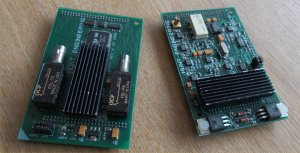Data transmission over SONAR tow cables
Having worked on SONAR systems before, we had several clients that we helped with Electronics for their SONAR systems. We had provided both DSP boards, and FPGA boards for different systems.
A common difficulty with towed array SONARs is that there needs to be both power and data connections in the tow cable between the boat and the towed array. The tow cable must be connected to the boat using a mounting that allows movement when the towed array is winched in and out, and when it moves in the water. This usually means that there are electrical slip rings in the cable and that can introduce noise into the connection.
We discussed with the clients the need to send a large volume of data over a light and flexible cable and decided to explore using optical fibers.
We found that it is possible to transmit data in both directions on a single optical fiber, by using different wavelengths of light for the two directions.
The use of an optical slip ring in the tow cable produces less noise and hence errors than the copper equivalent, but because the data is digital, the data can be packetised and error checked using techniques like checksums. Then any packets that have errors detected can be re-sent.

Customers were very happy with this interface for their new systems, and wanted to use some of the advantages in legacy systems where it would be too expensive to replace the whole tow cable assembly with mountings and slip-rings.
So we developed two further versions of the interface - one with two differential twisted pair connections (one for each direction), and another that used a single 50 Ohm co-axial connection. The co-ax version used RF modulation to re-create the ability to transmit data in both directions.
Although these copper versions of the interface had higher error rates introduced by the slip rings, the same error detection and correction techniques could be used, because the data was digital and has a higher throughput than the legacy systems required.